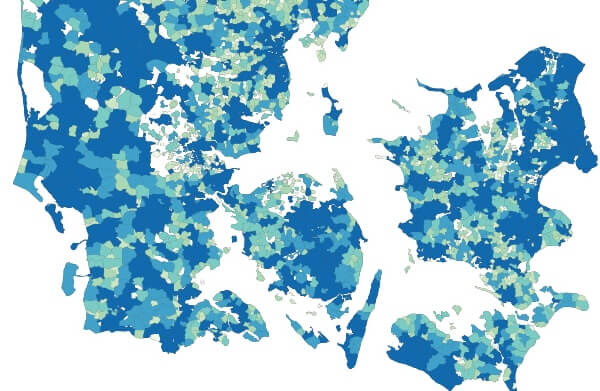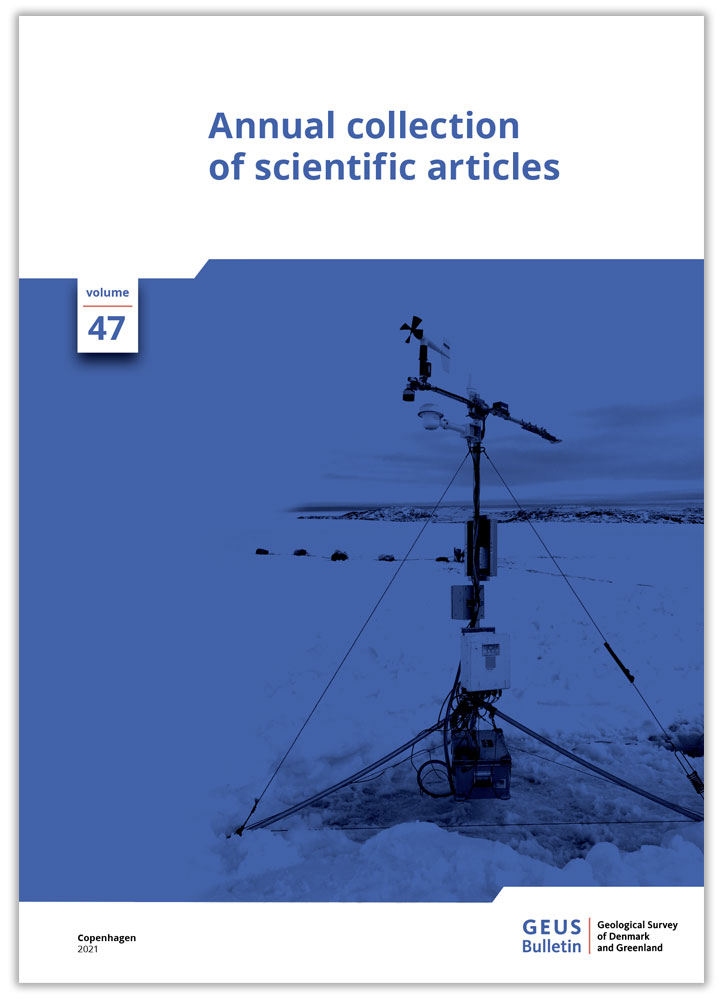
How to Cite
Share
Abstract
Pesticide pollution has raised public concern in Denmark due to potential negative health impacts and frequent findings of new substances after a recent expansion of the groundwater monitoring programme. Danish drinking water comes entirely from groundwater. Both the raw groundwater and the treated drinking water are regularly monitored, and the chemical analyses are reported to a publicly available national database (Jupiter). Based on these data, in this study we (1) provide a status of pesticide content in drinking water supplied by public waterworks in Denmark and (2) assess the proportion of Danish households exposed to pesticides from drinking water. ‘Pesticides’ here refers also to their metabolites, degradation and reaction products. The cleaned dataset represents 3004 public waterworks distributed throughout the country and includes 39 798 samples of treated drinking water analysed for 449 pesticides (971 723 analyses total) for the period 2002–2019. Of all these chemical analyses, 0.5% (n = 4925) contained a quantified pesticide (>0.03 μg/l). Pesticides were found at least once in the treated drinking water at 29% of all sampled public waterworks for the period 2002–2019 and at 21% of the waterworks for the recent period 2015–2019. We estimate that 56% of all Danish households were potentially exposed at least once to pesticides in drinking water at concentrations of 0.03–4.00 μg/l between 2002 and 2019. However, in 2015–2019, the proportion of the Danish households exposed to pesticides (0.03–4.00 μg/l) was 41%. The proportion of Danish households potentially exposed at least once to pesticides above the maximum allowed concentration (0.1 μg/l) according to the EU Drinking Water Directive (and the Danish drinking water standard) was 19% for 2002–2019 and 11% for 2015–2019. However, the maximum concentrations were lower than the World Health Organization’s compound-specific guidelines. Lastly, we explore data complexity and discuss the limitations imposed by data heterogeneity to facilitate future epidemiological studies.
How to Cite
Share
Copyright (c) 2021 Denitza D. Voutchkova, Jörg Schullehner, Carina Skaarup, Kirstine Wodschow, Annette Kjær Ersbøll, Birgitte Hansen

This work is licensed under a Creative Commons Attribution 4.0 International License.
Supplementary Files
Funding
This work was funded under the project ‘Geographical clustering of leukaemia and multiple myeloma and association with pesticides in ground water’ by the Karen Elise Jensen Fond (2017–2021).Downloads
An annual collection of articles submitted to GEUS Bulletin, published throughout 2021.
Cover photo: Wehrlé et al. 2022 (DOI:10.34194/geusb.v47.5284).
References
-
Antweiler, R.C. 2015: Evaluation of statistical treatments of left-censored environmental data using coincident uncensored data sets. II. Group comparisons. Environmental Science and Technology 49, 13439–13446. https://doi.org/10.1021/acs.est.5b02385
-
Antweiler, R.C. & Taylor, H.E. 2008: Evaluation of statistical treatments of left-censored environmental data using coincident uncensored data sets: I. Summary statistics. Environmental Science and Technology 42, 3732–3738. https://doi.org/10.1021/es071301c
-
Bexfield, L.M., Belitz, K., Lindsey, B.D., Toccalino, P.L. & Nowell, L.H. 2021: Pesticides and pesticide degradates in groundwater used for public supply across the United States: occurrence and human-health context. Environmental Science and Technology 55, 362–372. https://doi.org/10.1021/acs.est.0c05793
-
Bichel hovedudvalget. 1999. Bichel-Udvalget, Udvalget til vurdering af de samlede konsekvenser af en hel eller delvis afvikling af pesticidanvendelsen (In Danish only). Copenhagen: Miljø og Energiministeriet. https://mst.dk/service/publikationer/publikationsarkiv/1999/maj/rapport-fra-hovedudvalget/ (accessed February 2021)
-
Bourguignon, D. 2016: The precautionary principle: definitions, applications and governance: in-depth analysis. European Parliament, Directorate-General for Parliamentary Research Services. Luxembourg: Publications Office of the European Union. http://bookshop.europa.eu/uri?target=EUB:NOTICE:QA0115945:EN:HTML (accessed July 2020)
-
Brüsch, W., Stockmarr, J., Kelstrup, N., von Platen-Hallermund, F., Rosenberg, P. 2004: Pesticidforurenet vand i små vandforsyninger (GEUS Rapport No. 2004/9). (In Danish only). Copenhagen: Geological Survey of Denmark and Greenland.
-
Casida, J.E. 2009: Pest toxicology: the primary mechanisms of pesticide action. Chemical Research in Toxicology 22, 609–619. https://doi.org/10.1021/tx8004949
-
Commission of the European Communities. 2009: Commission Directive 2009/90/EC of 31 July 2009 laying down, pursuant to Directive 2000/60/EC of the European Parliament and of the Council, technical specifications for chemical analysis and monitoring of water status. Official Journal of the European Union L 201 1.8.2009, 36. http://data.europa.eu/eli/dir/2009/90/oj (accessed July 2020)
-
Council of the European Union. 2015: Council Directive 98/83/EC of 3 November 1998 on the quality of water intended for human consumption. Official Journal of the European Union L 330 5.12.1998, 32. http://data.europa.eu/eli/dir/1998/83/2015-10-27 (accessed June 2020)
-
Dolan, T., Howsam, P., Parsons, D.J. & Whelan, M.J. 2013: Is the EU drinking water directive standard for pesticides in drinking water consistent with the precautionary principle? Environmental Science and Technology 47, 4999–5006. https://doi.org/10.1021/es304955g
-
Dowle, M. & Srinivasan, A. 2019: data.table: extension of ‘data.frame’. R package version 1.12.2. https://CRAN.R-project.org/package=data.table
-
European Commission. 2018. Proposal for a Directive of the European Parliament and of the Council on the quality of water intended for human consumption (recast). COM/2017/0753 final - 2017/0332 (COD). https://eur-lex.europa.eu/legal-content/EN/ALL/?uri=CELEX:52017PC0753 (accessed February 2021)
-
Food and Agriculture Organization & World Health Organization. 2019: Detoxifying agriculture and health from highly hazardous pesticides – a call for action. Rome: Food and Agriculture Organization. https://www.who.int/neglected_diseases/vector_ecology/resources/9789241517065/en/ (accessed February 2021)
-
Fenner, K., Canonica, S., Wackett, L.P., Elsner, M. 2013: Evaluating pesticide degradation in the environment: blind spots and emerging opportunities. Science 341, 752–758. https://doi.org/10.1126/science.1236281
-
Ferrier, H., Nieuwenhuijsen, M., Boobis, A., Elliott, P. 2002: Current knowledge and recent developments in consumer exposure assessment of pesticides: a UK perspective. Food Additives and Contaminants 19, 837–852. https://doi.org/10.1080/02652030210156322
-
Hansen, C.T., Ritz, C., Gerhard, D., Jensen, J.E., Streibig, J.C. 2016: Reply to: comments on the paper: re-evaluation of groundwater monitoring data for glyphosate and bentazone by taking detection limits into account. Science of The Total Environment 557–558, 916. https://doi.org/10.1016/j.scitotenv.2016.03.116
-
Hansen, C.T., Ritz, C., Gerhard, D., Jensen, J.E., Streibig, J.C. 2015: Re-evaluation of groundwater monitoring data for glyphosate and bentazone by taking detection limits into account. Science of The Total Environment 536, 68–71. https://doi.org/10.1016/j.scitotenv.2015.07.047
-
Helsel, D.R. 2005: More than obvious: better methods for interpretting nondetect data. Environmental Science and Technology 39, 419A–423A. https://doi.org/10.1021/es053368a
-
Inkscape Project. 2019: Inkscape 0.92.4 https://inkscape.org (accessed February 2021)
-
Johnsen, A.R., Thorling, L., Helsel, D.R., Larsen, F. 2016: Comments on the article: re-evaluation of groundwater monitoring data for glyphosate and bentazone by taking detection limits into account. Science of The Total Environment 557–558, 914–915. https://doi.org/10.1016/j.scitotenv.2016.02.130
-
Kim, K.-H., Kabir, E., Jahan, S.A. 2017: Exposure to pesticides and the associated human health effects. Science of The Total Environment 575, 525–535. https://doi.org/10.1016/j.scitotenv.2016.09.009
-
Kohler, H.-R. & Triebskorn, R. 2013: Wildlife ecotoxicology of pesticides: can we track effects to the population level and beyond? Science 341, 759–765. https://doi.org/10.1126/science.1237591
-
Li, Z. & Jennings, A. 2018.: Global variations in pesticide regulations and health risk assessment of maximum concentration levels in drinking water. Journal of Environmental Management 212, 384–394. https://doi.org/10.1016/j.jenvman.2017.12.083
-
Mathiesen, S.R. 2020: Massescreening viser ulovlige sprøjtemidler i grundvandet (in Danish only). Maskinbladet. https://www.maskinbladet.dk/artikel/66875-massescreening-viser-ulovlige-sprojtemidler-i-grundvandet (accessed April 2020)
-
Miljøstyrelsen. 2020a. Kortlægning af tilladelser til videregående vandbehandling 2012 – 2019 (in Danish only). Government memo. Odense: Miljøstyrelsen. https://mst.dk/media/203285/resultat-af-kortlaegningen-2012-2019-090720.pdf (accessed January 2021)
-
Miljøstyrelsen. 2020b. Vejledning om indberetning og godkendelse af vandforsyningsdata I Jupiterdatabasen ‘Jupitervejledning’. Vejledning 116 (in Danish only). Government report. Odense: Miljøstyrelsen. https://mst.dk/natur-vand/vand-i-hverdagen/drikkevand/indberetning-og-godkendelse-af-vandforsyningsdata-jupitervejledningen/ (accessed July 2020)
-
Mohaupt, V. et al. 2020: Pesticides in European rivers, lakes and groundwaters – data assessment (ETC/ICM Technical Report No. 1/2020). Magdeburg: European Topic on Inland, Coastal and Marine waters (ETC/ICM). https://www.eionet.europa.eu/etcs/etc-icm/products/etc-icm-report-1-2020-pesticides-in-european-rivers-lakes-and-groundwaters-data-assessment (accessed November 2020)
-
Naturstyrelsen. 2012. Videregående vandbehandling: Kortlægning af kommunernes tilladelser (in Danish only). Government report. Copenhagen: Naturstyrelsen. https://naturstyrelsen.dk/media/nst/Attachments/Videregende_vandbehandling_2012.pdf (accessed July 2020)
-
Pedersen, M.G. 2018: Geocoding of Danish addresses from the Residence Database version 2016, 1–7. Institutional report. Aarhus: Centre for Integrated Register-Based Research. https://cirrau.au.dk/fileadmin/cirrau/Documents/ophold2016b.pdf (accessed July 2020)
-
QGIS Development Team. 2019: QGIS geographic information system. Open Source Geospatial Foundation Project. http://qgis.osgeo.org
-
R Core Team. 2019: R: A language and environment for statistical computing. R v. 4.0.2 Foundation for Statistical Computing, Vienna, Austria. https://www.R-project.org/
-
Rosenstock, L. 1991: Chronic central nervous system effects of acute organophosphate pesticide intoxication. The Lancet 338, 223–227. https://doi.org/10.1016/0140-6736(91)90356-T
-
RStudio Team. 2018: RStudio: Integrated development for R. RStudio Inc., Boston, MA, USA. http://www.rstudio.com/
-
Schullehner, J. & Hansen, B. 2014: Nitrate exposure from drinking water in Denmark over the last 35 years. Environmental Research Letters 9, 095001. https://doi.org/10.1088/1748-9326/9/9/095001
-
Schullehner, J., Jensen, N.L., Thygesen, M., Hansen, B., Sigsgaard, T. 2017: Drinking water nitrate estimation at household-level in Danish population-based long-term epidemiologic studies. Journal of Geochemical Exploration 183, 178–186. https://doi.org/10.1016/j.gexplo.2017.03.006
-
Sjerps, R.M.A., Kooij, P.J.F., van Loon, A., Van Wezel, A.P. 2019: Occurrence of pesticides in Dutch drinking water sources. Chemosphere 235, 510–518. https://doi.org/10.1016/j.chemosphere.2019.06.207
-
Stehle, S. & Schulz, R. 2015: Agricultural insecticides threaten surface waters at the global scale. Proceedings of the National Acadamy of Sciences 112, 5750–5755. https://doi.org/10.1073/pnas.1500232112
-
Stow, C.A., Webster, K.E., Wagner, T., Lottig, N., Soranno, P.A., Cha, Y. 2018: Small values in big data: the continuing need for appropriate metadata. Ecological Informatics 45, 26–30. https://doi.org/10.1016/j.ecoinf.2018.03.002
-
Thorling, L., Ditlefsen, C., Ernstsen, V., Hansen, B., Johnsen, A.R., Troldborg, L. 2019: Grundvandovervågning. Status og udvikling 1989 – 2018 (in Danish only). Institutional report. Copenhagen: Geological Survey of Denmark and Greenland.
-
Voutchkova, D., Schullehner, J., Knudsen, N., Jørgensen, L., Ersbøll, A., Kristiansen, S., Hansen, B. 2015: Exposure to selected geogenic trace elements (I, Li, and Sr) from drinking water in Denmark. Geosciences 5, 45–66. https://doi.org/10.3390/geosciences5010045
-
Wickham, H. 2016: ggplot2: Elegant graphics for data analysis. New York, NY: Springer-Verlag. https://ggplot2.tidyverse.org
-
Wickham, H., François, R., Henry, L. & Müller, K. 2019: dplyr: a grammar of data manipulation. R package version 0.8.3. https://CRAN.R-project.org/package=dplyr
-
Wickham, H. & Henry, L. 2019: tidyr: Tidy Messy Data. R package version 1.0.0. https://CRAN.R-project.org/package=tidyr
-
World Health Organization. 2011: Guidelines for drinking-water quality, 4th edition. Geneva: World Health Organization. https://www.who.int/publications/i/item/9789241548151 (accessed January 2020)
-
World Health Organization. 2017: Guidelines for drinking-water quality, 4th edition, incorporating the first addendum. Geneva: World Health Organization. https://www.who.int/publications/i/item/9789241549950 (accessed July 2020)
-
World Health Organization. 2019a. Preventing disease through healthy environments. Exposure to highly hazardous pesticides: major public health concern. Geneva: World Health Organization. https://apps.who.int/iris/handle/10665/329501 (accessed July 2020)
-
World Health Organization. 2019b: WHO recommended classification of pesticides by hazard and guidelines to classification, revision 2019. Geneva: World Health Organization. https://apps.who.int/iris/handle/10665/329501 (accessed July 2020)









